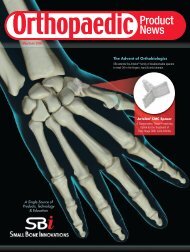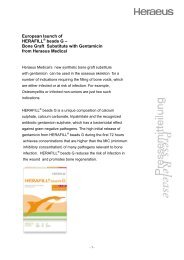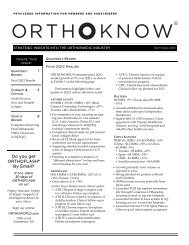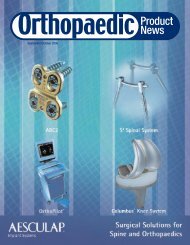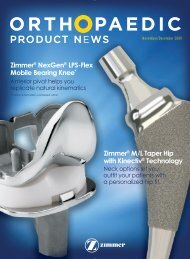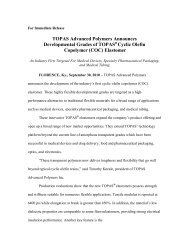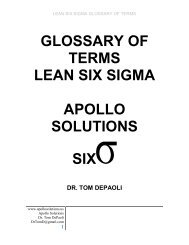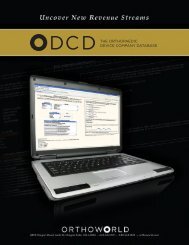AAOS, Arthroscopy - Orthoworld
AAOS, Arthroscopy - Orthoworld
AAOS, Arthroscopy - Orthoworld
You also want an ePaper? Increase the reach of your titles
YUMPU automatically turns print PDFs into web optimized ePapers that Google loves.
INTELLECTUAL PROPERTY UPDATEcontinued from page 16The trademark application “prosecution” process includes severalphases. The first is the actual review of the application and trademark bythe USPTO that follows the initial clerical approval that the applicationincludes the above eight elements and assignment of a serial number.After this administrative phase is complete, the USPTO assigns anexamining attorney to perform the substantive examination of thetrademark. Depending upon the USPTO workload at the time of filing,the applicant may not hear anything regarding their submission from theUSPTO for upwards of six months.During the second phase, the examining attorney will perform acomprehensive search for conflicting marks, examine the writtenapplication, the drawing and any filed specimen. The search that isperformed is to determine whether there is a “likelihood of confusion”that exists between the applicant’s trademark and another mark that iseither registered or pending in the USPTO. The key factors consideredby the examining attorney when making the determination of theexistence of a “likelihood of confusion” are similarity of marks, and thecommercial relationship between the listed goods and/or services of thetwo marks (i.e., channels of commerce of the two marks). Conflicts areusually found when the marks are similar and the goods are related.The examining attorney will also evaluate the applicant’s trademarkto determine whether the mark is “merely descriptive,” deceptivelymisdescriptive, geographically descriptive, merely a surname orornamental. It should be noted that these are only a few of the manypossible grounds for refusal to register.In the event the examining attorney decides that the trademarkshould not be registered for any of the above reasons, an Office Action isissued providing the reasons for refusal. The applicant then has sixmonths from the mailing date of the Office Action to respond or theapplication will become abandoned. If in response to the Office Actionthe applicant is still unsuccessful in overcoming the USPTO’s objectives,a final refusal is issued. An applicant can appeal the final refusal, but thisis usually a costly endeavor.If the applicant is lucky, the examining attorney will raise noobjections to the application and the trademark will be approved forpublication in the Official Gazette. This third phase is called Publicationfor Opposition. What will occur is a Notice of Publication is issued bythe USPTO stating the date of publication of the proposed trademark.Any third party who believes that it may be damaged by registration ofapplicant’s trademark has thirty days from the publication date in whichto file an opposition to registering the mark. In the event no opposition israised or the opposition is not successful, the applicant’s application willproceed to the final phase of the registration process.The final phase will depend upon the type of application filed. If theapplication was based on prior “use” of the trademark, then a Certificateof Registration will be issued. If the application was based on an “intentto-use,”then a Notice of Allowance will issue giving the applicant a sixmonth time period to either file a Statement of Use or request a sixmonthextension of time to file a Statement of Use.All applicants need to be aware of a very subtle but extremelyimportant result of the registration process. When one files a trademarkapplication, the application is for registering a trademark on the PrincipalTrademark Register. Unfortunately, not all marks will reach the PricipalRegister. The USPTO maintains two registers, the Principal and theSupplemental. Registration on either register entitles the owner to use the® symbol with the mark. Registration on the Principal Register isreserved for marks found by the examining attorney to be distinctive.Benefits to being on the Principal Register include notice of ownership,conclusive evidence of the owner’s exclusive right to use the mark incommerce, the mark becomes incontestable after five years, and the rightto receive treble (or triple) damages. Marks registered on theSupplemental Register are usually those that have been determined to be“merely descriptive” by the examining attorney and have not achievedsecondary meaning or distinctiveness. Benefits to being registered on theSupplemental Register include having the ability to bring suit in Federalcourt, is a deterrent to others from using a similar mark, and the abilityto move the mark from Supplemental Register to Primary Register afterfive years of exclusive and continuing use that can be interpreted by theexamining attorney as a showing of distinctiveness when registration isapplied for a second time.Following the registration of the trademark, the new owner of themark must remember that the term of registration is only for ten yearsand that the registration must be renewed every ten years thereafter.What is even more important to remember is that between the fifth andsixth year of the initial ten year term, the owner must file an affidavit(e.g. Section 8 & 15 affidavit for the Principal Register, Section 8affidavit for the Supplemental Register) to confirm that the trademark isstill in use in order to maintain the registration. If the owner fails tosubmit the affidavit, the trademark registration will be canceled. Further,the owner must remember to renew the trademark registration every tenyears by filing a Section 9 affidavit. An owner may maintain theregistration of the trademark for an indefinite period of time as long asall the proper affidavits are filed in a timely fashion and the trademark iscontinually used in commerce.In order for an owner to maintain the value in his trademark, it isimperative that he monitor the marketplace and the Official Gazette tomake sure others are not using the trademark or are trying to register asimilar mark in an attempt to cause confusion for the consumer orcustomers. In addition, the owner of the trademark should be diligent informulating and publishing corporate policies (e.g. posting policies onthe company website) that dictate who may use the mark and how themark must be used. Taking these actions assists the owner in maintainingthe distinctiveness of the trademark and will hopefully keep thetrademark from becoming generic. It is very important to remember to bediligent in policing compliance by third party users of the trademark ofthese use policies in order to maintain the registered trademark as animportant corporate asset.By taking the above policing steps, an owner is actively guardinghimself against someone infringing his trademark. The resultant injurythat all owners of trademarks want to avoid is consumer or customerconfusion of the source of their goods because someone else is using thetrademark, and the resultant damage to the owner’s goodwill because ofthe consumer or customer confusion. The test of actual trademarkinfringement is whether another party’s use of the owner’s trademark islikely to cause a consumer to be confused about the source of the goodsor services. The simple question is, “Does the use of the mark create alikelihood of confusion?” If the answer is yes, then the other party hasinfringed the owner’s trademark.When making the decision as to the question of whether a likelihoodof confusion exists, courts look at numerous factors including similarityof appearance, similarity of marketing or sales channels and the level ofsophistication of the buyers of the goods. Defendants in trademarkinfringement lawsuits usually try to defend their actions by claiming fairuse of the mark, abandonment of the mark by the owner or that the markis invalid.Several remedies are available to the trademark owner that have beensuccessful after taking legal action for trademark infringement.Injunctions are commonly used to protect the winner of an infringementaction. Preliminary injunctions are sometimes granted if several factorsare met, including the possibility of irreparable harm to the owner.continued on page 2018 Orthopaedic Product News • January/February 2007



